Chapter 16 Jormain Cady and Joyce A. Jackowski 1. Describe the prevalence, incidence, survival, and mortality rates of cancer in the United States. 2. Describe the processes involved in the biology of cancer. 3. Differentiate the three phases of cancer development. 4. Describe the role of the immune system related to cancer. 5. Differentiate among the various classifications of drugs used to treat cancer. 6. Discuss the role of the nurse in the prevention, detection, and diagnosis of cancer. 7. Explain the use of surgery, chemotherapy, radiation therapy, and biologic and targeted therapies in the treatment of cancer. 8. Identify the classifications of chemotherapy agents and methods of administration. 9. Differentiate between teletherapy (external beam radiation) and brachytherapy (internal radiation). 10. Describe the effects of radiation therapy and chemotherapy on normal tissues. 11. Identify the types and effects of biologic and targeted therapy agents. 12. Describe the nursing management of patients receiving chemotherapy, radiation therapy, and biologic and targeted therapy. 13. Describe nutritional therapy for patients with cancer. 14. Identify the various complications associated with advanced cancer. 15. Describe the psychologic support interventions for cancer patients, cancer survivors, and their caregivers. Cancer is a group of more than 200 diseases characterized by uncontrolled and unregulated growth of cells. Although cancer is often considered a disease of aging, with the majority of cases (77%) diagnosed in those over age 55 years, it occurs in people of all ages. An estimated 1,660,290 people in the United States are diagnosed annually with invasive carcinoma (excluding basal and squamous cell skin cancers).1 eTABLE 16-1 KARNOFSKY FUNCTIONAL PERFORMANCE SCALE eTABLE 16-2 KATZ INDEX OF INDEPENDENCE IN ACTIVITIES OF DAILY LIVING Copyright © The Gerontological Society of America. Adapted with permission of the publisher. Slightly adapted from Katz S, Down TD, Cash HR, et al: Progress in the development of the index of ADL, Gerontologist 10:20, 1970. eTABLE 16-3 SCREENING GUIDELINES FOR EARLY DETECTION OF CANCER IN ASYMPTOMATIC PEOPLE *Colonoscopy should be done if test results are positive. †For FOBT or FIT used as a screening test, the take-home multiple sample method should be used. An FOBT or FIT performed during a digital rectal examination in the health care provider’s office is not adequate for screening. Source: American Cancer Society Guidelines for the early detection of cancer. Available at www.cancer.org/Healthy/FindCancerEarly/CancerScreeningGuidelines/american-cancer-society-guidelines-for-the-early-detection-of-cancer. TABLE 16-4 The principles of radiotherapy dosing and fractionation are guided by the biologic dynamics of cellular response to radiation. eTABLE 16-5 eTABLE 16-6 PRECAUTIONS TO MINIMIZE RISKS FROM NEUTROPENIA Source: Neutropenia Support Association. Available at http://www.neutropenia.ca/about/living.html. eTABLE 16-7 DRUG THERAPY Overall the incidence of cancer has been declining since the 1990s. The mortality rate for the most common cancers (prostate, breast, lung, and colorectal) is also declining.2 The incidences of many cancers, such as colorectal, lung, breast, and oropharyngeal cancers, have declined largely as a result of preventive efforts. However, the incidence of other types of cancers, such as leukemia, liver cancer, and skin cancers, has been on the rise. Notably, the incidence of melanoma rose faster than that for any other malignancy in the United States.1 Cancer incidence overall is higher in men than women. Gender differences in incidence and in death rates for specific cancers are presented in Tables 16-1 and 16-2 and the Gender Differences box. Although mortality rates from all cancers combined are on the decline, cancer is still the second most common cause of death in the United States (heart disease is the most common). However, in people less than 85 years of age, cancer is the leading cause of death. Annually about 580,350 Americans are expected to die as a result of cancer, which is more than 1500 people per day.1 TABLE 16-1 CANCER INCIDENCE BY SITE AND GENDER* *Numbers are estimates excluding basal and squamous cell skin cancers and carcinoma in situ. Source: American Cancer Society: Cancer facts and figures, Atlanta, 2012, The Society. Retrieved from www.cancer.org/acs/groups/content/@epidemiologysurveilance/documents/document/acspc-036845.pdf. TABLE 16-2 CANCER DEATHS BY SITE AND GENDER*
Cancer
Definitions
Percentage
Criteria
Able to carry on normal activity and to work; no special care needed
100
Normal; no complaints; no evidence of disease
90
Ability to carry on normal activity; minor signs or symptoms of disease
80
Normal activity with effort; some signs or symptoms of disease
Unable to work; able to live at home and care for most personal needs; varying amount of assistance needed
70
Ability to care for self; inability to carry on normal activity or do active work
60
Occasional assistance necessary but ability to care for most needs
50
Considerable assistance and frequent medical care necessary
Unable to care for self; requires equivalent of institutional or hospital care; disease may be progressing rapidly
40
Disabled; special care and assistance necessary
30
Severely disabled; indication for hospitalization although death not imminent
20
Very sick; hospitalization necessary; active supportive treatment necessary
10
Moribund; fatal processes progressing rapidly
0
Dead
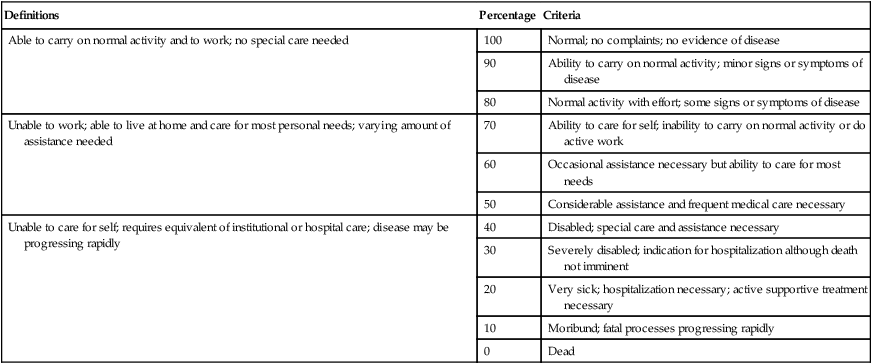
Activities
Independence
Dependence
Points (1 or 0)
(1 Point) NO supervision, direction, or personal assistance
(0 Points) WITH supervision, direction, personal assistance, or total care
Bathing
(1 POINT) Bathes self completely or needs help in bathing only a single part of the body such as the back, genital area, or disabled extremity.
(0 POINTS) Needs help with bathing more than one part of the body, getting in or out of the tub or shower. Requires total bathing.
points:_______
Dressing
(1 POINT) Gets clothes from closets and drawers and puts on clothes and outer garments complete with fasteners. May have help tying shoes.
(0 POINTS) Needs help with dressing self or needs to be completely dressed.
points:_______
Toileting
(1 POINT) Goes to toilet, gets on and off, arranges clothes, cleans genital area without help.
(0 POINTS) Needs help transferring to the toilet or cleaning self, or uses bedpan or commode.
points:_______
Transferring
(1 POINT) Moves in and out of bed or chair unassisted. Mechanical transferring aides are acceptable.
(0 POINTS) Needs help in moving from bed to chair or requires a complete transfer.
points:_______
Continence
(1 POINT) Exercises complete self-control over urination and defecation.
(0 POINTS) Is partially or totally incontinent of bowel or bladder.
points:_______
Feeding
(1 POINT) Gets food from plate into mouth without help. Preparation of food may be done by another person.
(0 POINTS) Needs partial or total help with feeding or requires parenteral feeding.
points:_______
TOTAL POINTS = _______
6 = High (patient independent)
0 = Low (patient very dependent)
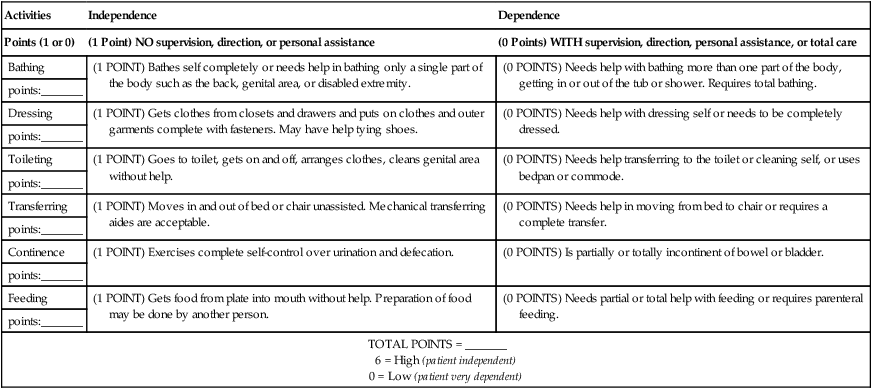
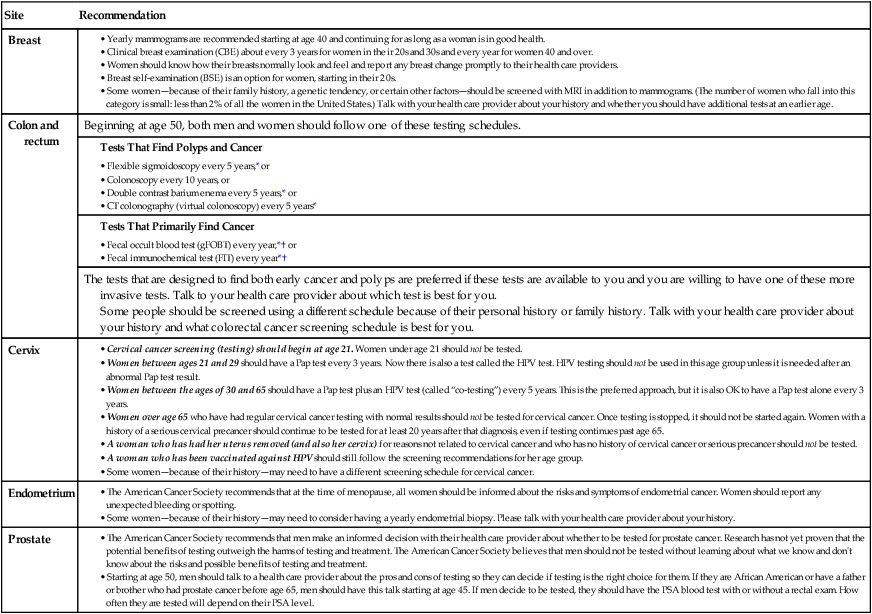
Use
Description
Definitive or primary therapy
Neoadjuvant therapy
Adjuvant therapy
Prophylaxis
Disease control
Palliation

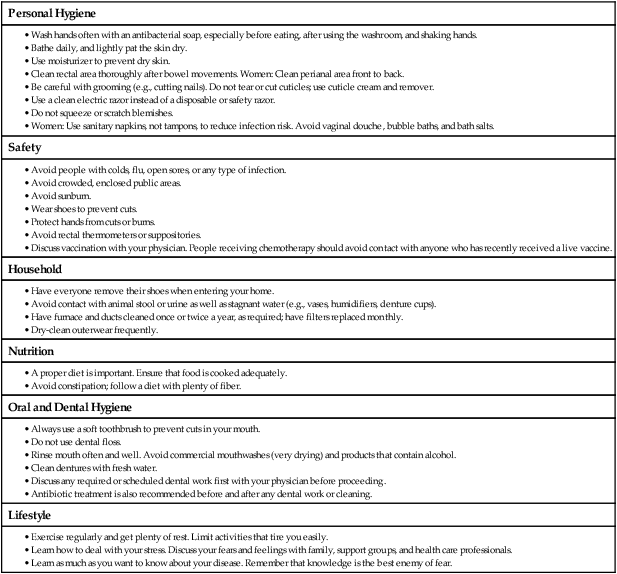
Biologic and Targeted Therapy (Enhanced)
Drug
Mechanism of Action
Indications
Side Effects
α-interferon (Roferon-A, Intron A)
Inhibits DNA and protein synthesis
Suppresses cell proliferation
Increases cytotoxic effects of natural killer (NK) cells
Hairy cell leukemia, chronic myelogenous leukemia, malignant melanoma, renal cell carcinoma, ovarian cancer, multiple myeloma, Kaposi sarcoma
Flu-like syndrome (fever, chills, myalgia, headache), cognitive changes, fatigue, nausea, vomiting, anorexia, weight loss
interleukin-2 (aldesleukin [Proleukin])
Stimulates proliferation of T and B cells
Activates NK cells
Metastatic renal cell cancer, metastatic melanoma
Same as above; capillary leak syndrome resulting in hypotension; bone marrow suppression
BCG vaccine (TheraCys)
Induces an immune response that prevents angiogenesis of tumor
In situ bladder cancer
Flu-like syndrome, nausea, vomiting, rash, cough
Epidermal Growth Factor Receptor (EGFR)—Tyrosine Kinase (TK) Inhibitors
cetuximab (Erbitux)
Inhibits EGFR
Colorectal cancer, head and neck cancer
Rash, infusion reactions, interstitial lung disease
panitumumab (Vectibix)
Inhibits EGFR
Colorectal cancer
Pulmonary fibrosis, severe skin rash complicated with infections, infusion reactions, interstitial lung disease
erlotinib (Tarceva)
Inhibits EGFR-TK
Non–small cell lung cancer, advanced pancreatic cancer
Rash, diarrhea, interstitial lung disease
gefitinib (Iressa)
Inhibits EGFR-TK
Non–small cell lung cancer
Rash, diarrhea, interstitial lung disease
lapatinib (Tykerb)
Inhibits EGFR-TK and binds receptor HER-2
Advanced breast cancer that is HER-2 positive
Cardiotoxicity, diarrhea, rash, nausea, vomiting, hand-foot syndrome
BCR-ABL Tyrosine Kinase Inhibitors
imatinib (Gleevec)
Inhibits BCR-ABL tyrosine kinase
Chronic myeloid leukemia, GI stromal tumors (GIST)
Nausea, diarrhea, myalgia, fluid retention
nilotinib (Tasigna)
Inhibits BCR-ABL tyrosine kinase
Chronic myeloid leukemia
Neutropenia, thrombocytopenia, bleeding, nausea, fatigue, elevated lipase level, fever, rash, pruritus, diarrhea, pneumonia
dasatinib (Sprycel)
Inhibits BCR-ABL tyrosine kinase
Chronic myeloid leukemia
Myelosuppression, CNS or GI hemorrhage, fever, pleural effusion, pneumonia, cardiac failure, fluid retention, abdominal pain
CD20 Monoclonal Antibodies
rituximab (Rituxan)
Binds CD20 antigen, causing cytotoxicity
Non-Hodgkin’s lymphoma (B cell)
Fever, chills, nausea, headache, urticaria
ofatumumab (Arzerra)
Binds CD20 antigen, causing cytotoxicity
Chronic lymphocytic leukemia
Increased risk for infection
ibritumomab tiuxetan/yttrium-90 (Zevalin)
Binds CD20 antigen, causing cytotoxicity and radiation injury
Non-Hodgkin’s lymphoma (B cell)
Bone marrow suppression, fatigue, nausea, chills
tositumomab/131I tositumomab (Bexxar)
Binds CD20 antigen, causing immune attack and radiation injury
Non-Hodgkin’s lymphoma (B cell)
Bone marrow suppression, fever, chills, nausea, headache
Angiogenesis Inhibitors
bevacizumab (Avastin)
Binds vascular endothelial growth factor (VEGF), thereby inhibiting angiogenesis
Colorectal cancer, non–small cell lung cancer, and renal cell carcinoma
Hypertension, colon bleeding and perforation, impaired wound healing, thromboembolism, diarrhea
pazopanib (Votrient)
Same as above
Advanced renal cell carcinoma
Diarrhea, hypertension, hair dyspigmentation, nausea, anorexia, vomiting
Proteasome Inhibitors
bortezomib (Velcade)
Inhibits proteasome activity, which functions to regulate cell growth
Multiple myeloma
Bone marrow suppression, nausea, vomiting, diarrhea, peripheral neuropathy, fatigue
carfilzomib
(Kyprolis)
Same as above
Multiple myeloma
Fatigue, low blood cell count and blood platelet levels, shortness of breath, diarrhea and fever; heart failure
Other Targeted Therapies
alemtuzumab (Campath)
Binds CD52 antigen (found on T and B cells, monocytes, NK cells, neutrophils)
Chronic lymphocytic leukemia (B cell), GIST
Bone marrow suppression, chills, fever, vomiting, diarrhea, fatigue
trastuzumab (Herceptin)
Binds human epidermal growth factor receptor 2 (HER-2)
Breast cancer (HER-2 positive)
Cardiotoxicity
pertuzumab (Perjeta)
Same as above
Breast cancer (HER-2 positive)
Cardiotoxicity
sorafenib (Nexavar)
Inhibits several tyrosine kinases
Advanced renal cell carcinoma
Rash, diarrhea, hypertension; redness, pain, swelling, or blisters on hands/feet
sunitinib (Sutent)
Inhibits several tyrosine kinases
Advanced renal cell carcinoma, GIST
Fatigue, heart failure, hypertension
temsirolimus (Torisel)
Inhibits a specific protein known as the mammalian target of rapamycin (mTOR)
Advanced renal cell carcinoma
Hyperlipidemia (specifically triglycerides), hyperglycemia, interstitial lung disease, renal failure, rash, nausea, fatigue
everolimus (Afinitor)
Same as above
Advanced renal cell carcinoma, advanced breast cancer
Mucositis, diarrhea, anorexia, edema, anemia, shortness of breath, coughing, nausea, vomiting, rash, fever
vemurafenib (Zelboraf)
Inhibits BRAF serine threonine kinase
BRAF V600E mutated metastatic melanoma
Hypersensitivity reactions, skin reactions including Stevens-Johnson syndrome, Q-T prolongation, elevated liver enzymes, photosensitivity, uveitis
ipilimumab (Yervoy)
Binds with CTLA-4 causing an anti-tumor mediated immune response
Metastatic melanoma or unresectable melanoma
Severe or life-threatening colitis, dermatitis, hepatotoxicity, and other organ reactions can occur
crizotinib (Xalkori)
Inhibits ALK tyrosine kinase
Locally advanced or metastatic non–small cell lung cancer that is ALK positive
Hepatotoxicity, pneumonitis, prolonged Q-T interval, N/V, diarrhea, edema, vision disorders
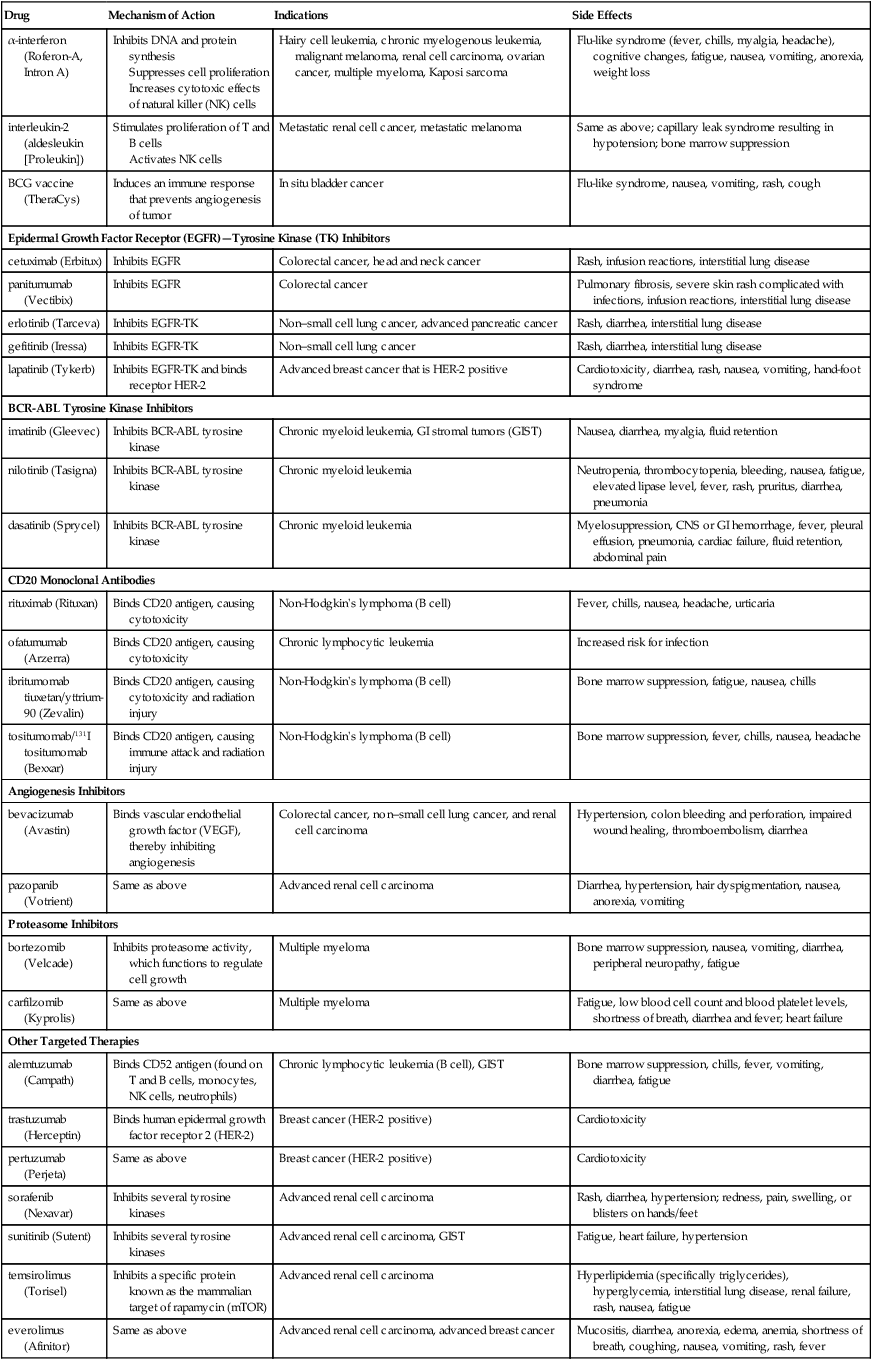

Male
Female
Type
%
Type
%
Prostate
28
Breast
29
Lung
14
Lung
14
Colon/rectum
9
Colon/rectum
9
Urinary bladder
6
Uterus
6
Melanoma
5
Thyroid
6
Kidney and renal pelvis
5
Non-Hodgkin’s lymphoma
4
Non-Hodgkin’s lymphoma
4
Melanoma
4
Oropharynx
3
Ovary
3
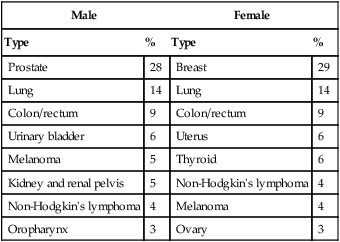
Male
Female
Type
%
Type
%
Lung and bronchus
28
Lung and bronchus
26
Prostate
10
Breast
14
Colon/rectum
9
Colon/rectum
9
Pancreas
6
Pancreas
7
Liver and intrahepatic bile ducts
5
Ovary
5
Leukemia
4
Leukemia
4
Non-Hodgkin’s lymphoma
3
Esophagus
4
Uterus
3
Urinary bladder
3
Liver and intrahepatic bile ducts
Brain and other nervous system
2
2
Non-Hodgkin’s lymphoma
3
Kidney and renal pelvis
3 ![]()
Stay updated, free articles. Join our Telegram channel

Full access? Get Clinical Tree


Nurse Key
Fastest Nurse Insight Engine
Get Clinical Tree app for offline access
